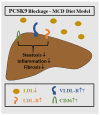Emerging Insights on the Diverse Roles of Proprotein Convertase Subtilisin/Kexin Type 9 (PCSK9) in Chronic Liver Diseases: Cholesterol Metabolism and Beyond
- PMID: 35162992
- PMCID: PMC8834914
- DOI: 10.3390/ijms23031070
Emerging Insights on the Diverse Roles of Proprotein Convertase Subtilisin/Kexin Type 9 (PCSK9) in Chronic Liver Diseases: Cholesterol Metabolism and Beyond
Abstract
Chronic liver diseases are commonly associated with dysregulated cholesterol metabolism. Proprotein convertase subtilisin/kexin type 9 (PCSK9) is a serine protease of the proprotein convertase family that is mainly synthetized and secreted by the liver, and represents one of the key regulators of circulating low-density lipoprotein (LDL) cholesterol levels. Its ability to bind and induce LDL-receptor degradation, in particular in the liver, increases circulating LDL-cholesterol levels in the blood. Hence, inhibition of PCSK9 has become a very potent tool for the treatment of hypercholesterolemia. Besides PCSK9 limiting entry of LDL-derived cholesterol, affecting multiple cholesterol-related functions in cells, more recent studies have associated PCSK9 with various other cellular processes, including inflammation, fatty acid metabolism, cancerogenesis and visceral adiposity. It is increasingly becoming evident that additional roles for PCSK9 beyond cholesterol homeostasis are crucial for liver physiology in health and disease, often contributing to pathophysiology. This review will summarize studies analyzing circulating and hepatic PCSK9 levels in patients with chronic liver diseases. The factors affecting PCSK9 levels in the circulation and in hepatocytes, clinically relevant studies and the pathophysiological role of PCSK9 in chronic liver injury are discussed.
Keywords: LDL-receptor; NAFLD; PCSK9; alcoholic liver disease; hepatitis C; visceral obesity.
Conflict of interest statement
The authors declare no conflict of interest.
Figures





Similar articles
-
Proprotein convertase subtilisin/kexin type 9 (PCSK9) levels are not associated with severity of liver disease and are inversely related to cholesterol in a cohort of thirty eight patients with liver cirrhosis.Lipids Health Dis. 2021 Jan 18;20(1):6. doi: 10.1186/s12944-021-01431-x. Lipids Health Dis. 2021. PMID: 33461570 Free PMC article.
-
Cyclase-associated protein 1 is a binding partner of proprotein convertase subtilisin/kexin type-9 and is required for the degradation of low-density lipoprotein receptors by proprotein convertase subtilisin/kexin type-9.Eur Heart J. 2020 Jan 7;41(2):239-252. doi: 10.1093/eurheartj/ehz566. Eur Heart J. 2020. PMID: 31419281 Free PMC article.
-
Proprotein Convertase Subtilisin/Kexin-Type 9 and Lipid Metabolism.Adv Exp Med Biol. 2020;1276:137-156. doi: 10.1007/978-981-15-6082-8_9. Adv Exp Med Biol. 2020. PMID: 32705598 Review.
-
Proprotein Convertase Subtilisin/Kexin Type 9 (PCSK9) Single Domain Antibodies Are Potent Inhibitors of Low Density Lipoprotein Receptor Degradation.J Biol Chem. 2016 Aug 5;291(32):16659-71. doi: 10.1074/jbc.M116.717736. Epub 2016 Jun 8. J Biol Chem. 2016. PMID: 27284008 Free PMC article.
-
Targeting the proprotein convertase subtilisin/kexin type 9 for the treatment of dyslipidemia and atherosclerosis.J Am Coll Cardiol. 2013 Oct 15;62(16):1401-8. doi: 10.1016/j.jacc.2013.07.056. Epub 2013 Aug 21. J Am Coll Cardiol. 2013. PMID: 23973703 Review.
Cited by
-
Cholesterol and COVID-19-therapeutic opportunities at the host/virus interface during cell entry.Life Sci Alliance. 2024 Feb 22;7(5):e202302453. doi: 10.26508/lsa.202302453. Print 2024 May. Life Sci Alliance. 2024. PMID: 38388172 Free PMC article. Review.
-
Proprotein Convertase Subtilisin/Kexin Type 9 Induction in COVID-19 Is Poorly Associated with Disease Severity and Cholesterol Levels.Infect Dis Rep. 2024 Jul 17;16(4):593-607. doi: 10.3390/idr16040045. Infect Dis Rep. 2024. PMID: 39051245 Free PMC article.
-
Plasma Proprotein Convertase Subtilisin/Kexin Type 9 (PCSK9) as a Possible Biomarker for Severe COVID-19.Viruses. 2023 Jul 6;15(7):1511. doi: 10.3390/v15071511. Viruses. 2023. PMID: 37515197 Free PMC article.
-
Exploring research trends and hotspots on PCSK9 inhibitor studies: a bibliometric and visual analysis spanning 2007 to 2023.Front Cardiovasc Med. 2024 Nov 22;11:1474472. doi: 10.3389/fcvm.2024.1474472. eCollection 2024. Front Cardiovasc Med. 2024. PMID: 39650150 Free PMC article.
-
A biochemical, theoretical and immunohistochemical study comparing the therapeutic efficacy of curcumin and taurine on T-2 toxin induced hepatotoxicity in rats.Front Mol Biosci. 2023 May 4;10:1172403. doi: 10.3389/fmolb.2023.1172403. eCollection 2023. Front Mol Biosci. 2023. PMID: 37214337 Free PMC article.
References
-
- Benjannet S., Rhainds D., Essalmani R., Mayne J., Wickham L., Jin W., Asselin M.C., Hamelin J., Varret M., Allard D., et al. NARC-1/PCSK9 and its natural mutants: Zymogen cleavage and effects on the low density lipoprotein (LDL) receptor and LDL cholesterol. J. Biol. Chem. 2004;279:48865–48875. doi: 10.1074/jbc.M409699200. - DOI - PubMed
-
- Cunningham D., Danley D.E., Geoghegan K.F., Griffor M.C., Hawkins J.L., Subashi T.A., Varghese A.H., Ammirati M.J., Culp J.S., Hoth L.R., et al. Structural and biophysical studies of PCSK9 and its mutants linked to familial hypercholesterolemia. Nat. Struct. Mol. Biol. 2007;14:413–419. doi: 10.1038/nsmb1235. - DOI - PubMed
Publication types
MeSH terms
Substances
LinkOut - more resources
Full Text Sources
Medical
Miscellaneous

